
Vladimír Jeník: "You can't cheat on the model"
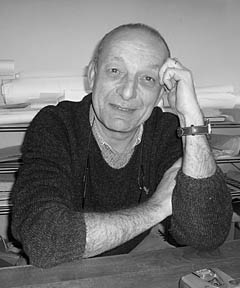 |
Mr. Jeník's model workshop is located at an address dedicated to architecture: In the former Holešovice factory for water meters, Joseph Pleskot and Ladislav Lábus also have their offices. Part of the ground floor of this industrial building was reconstructed in the mid-1990s for the model workshop by Markéta Cajthamlová in cooperation with Lev Lauermann. The simple, well-lit spaces still refer to Swiss cleanliness and precision - qualities that certainly are not foreign to the owner.
TECHNOLOGY AND DEVELOPMENT
It may sound incredible - and undoubtedly also admirable - but you have been dedicated to architectural models for over a quarter of a century. How much has the field changed since the early 1980s when you started?We have primarily gained new materials - some globally, others only in the Czech Republic. Technologies, polyurethanes, some types of plastics. Most models worldwide are made from plastics - mostly plexiglass, which is relatively stable and non-toxic. Our specialization must always utilize materials that are produced for large industries. Because nowhere in the world will anyone develop anything specifically for model makers. Polyurethanes are actually replacing wood for foundry or design studios of car manufacturers, which represent a large market. And precisely their prototypes are very close to our needs. Around the corner stands a computer-controlled milling machine, which is also a product of the aforementioned industry. In this regard, the field has changed quite a bit.
When I started, most model workshops relied on manual work from A to Z. Due to my long preceding experience with functional models - I made remote-controlled airplanes and cars - I was aware that it was essential for some parts to be machine-made. You can do almost anything by hand, but it takes a long time, and precision cannot be achieved. So I can say unpretentiously that I have partially brought automation into our field. Vlastimil Slíva, with whom I started, was an architect, immensely skilled, with vast experience. But he did everything with a knife and on the table. Even a lathe was a novelty for him.
Today the field is moving from amateur handcrafting to mechanical precision. And I enjoy this direction. Of course, it doesn't have to be like that: A model can be glued from a shoebox and still be beautiful. But I personally feel that some things should last a long time. Therefore, they must be made with substance - and that is why technology is important.
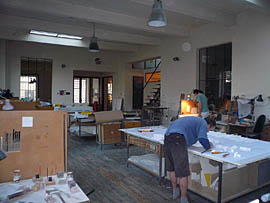 |
Certainly. Part of the destroyed models we made with Slíva. And we even received some of them for reconstruction. My current colleagues, who do not remember this period, sometimes laugh: For example, when they saw a strangely melted lump and I explained that it was a lawn made from crystal sugar and sprayed with paint...
Do you recall which model it specifically was?
It was one of the designs for the Na provázku theater for SIAL.
So you restored your own work. That’s rare. Can you give an approximation of the volume we are talking about?
Work is still ongoing, and the pace is related to the flow of funds from the Ministry of Culture. Approximately twenty models are restored each year. However, we do not work on the order by ourselves; my former colleagues, who now have their own companies, are also involved. Currently, we have two models in the workshop and a third will soon be added. So far, I estimate we've repaired about eight - for example, the design for the Na provázku theater or the model of the half-rounded Sněžka variant by Sial. Some were dismantled into their basic components. For me, this task is interesting precisely because I can see how capable we were of making models twenty years ago and how we do today. These are not mere assumptions but specific comparisons.
How does such restoration proceed? Do you use the same procedures - do you work manually again?
Mr. architect Krajči from the NTM certainly insists that the objects remain in their authentic form. I fully understand this requirement; however, we occasionally debate whether to repaint certain parts, as the water washed them away, and so forth. But of course, we cannot replace dissolved sugar with sugar again.
No?
Today, we achieve the same structure with other means.
BASIS AND CLIENTS
Let’s move on to the actual operation of the workshop. How many people do you employ?Between six and eight. I have tried more, but then it doesn't work well, because I lose control. With a smaller number of people, it's not possible to keep up with a larger order. Finding a compromise is very problematic.
And can you estimate how many models you make a year?
Approximately fifty to sixty.
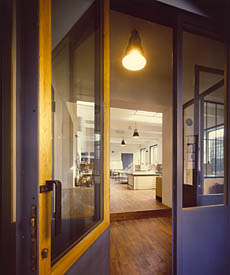 |
My people come from everywhere. The most important thing is interest and a personal approach. There is hardly any need for specific qualifications, but technical thinking and imagination are necessary. The model is usually made concurrently with the project, where the drawings are not always done properly. The materials for the models are usually still in the development phase. Which is a chapter in itself. Accurate materials are almost unknown in the Czech Republic.
Is it that bad?
I have the opportunity to compare. We have worked for Gehry, for Nouvel, for Meier... In fact, we repeatedly work for Richard Meier.
So you imply that the quality of the materials for models cannot be compared with foreign standards.
Architects in the Czech Republic do not know how to draw. Additionally, there is no uniform structure of planning documentation in the Czech Republic. In America, there is a law that mandates that every project be documented. The result is a sort of binder, everything is produced in A3 format regardless of the drawing scale. The entire project is uniformly printed. All layers in the computer - even if there are two hundred or three hundred - have a designated number. I turn off all layers, turn on number 33, and get the edge of the sidewalk. For every project.
Nothing like that exists in the Czech Republic: Each person, every office makes planning documentation differently. Even colleagues in the same office use different methods. They manage to do it because they draw on servers; the outputs are then shoved into a printer, and that's it. But when someone needs to orient themselves in the drawings and use the materials like we do for models, it doesn’t work. We have to draw it all again.
???
We redraw the drawings because the materials are ninety percent unusable: lines crossing over each other, unconnected lines, absolute chaos. I understand when someone makes a mistake. But these are not mistakes. This is a system - or rather, a non-system.
We made four models for the Plečnik exhibition, which allowed us access to copies of his plans: everything is there, and it’s absolutely accurate. Although they drew by hand, you will not find any errors there.
Today, no one wants to invest time into properly drawing something. And I often do it for them, but sometimes I tell myself: This is not my business. They can work on the computer better than I can; I learned it by myself, and here I sit, redoing and cursing...
Shouldn’t you set the parameters instead?
Of course. Beautiful. If there are no proper materials, there is no model. But I cannot say that in the Czech Republic.
Nevertheless, it sounds logical...
It sounds logical. But we would be out of work.
 |
General sloppiness. Beautiful Czechia, my Czechia... This situation begins already with the mapping materials sold by the city hall. A shameful state. Three contours overlapping, or not connected, half-broken, contour lines thirty years old combined with new ones. The car factory in Mladá Boleslav works because it is run by Germans. Without the introduction of order, they would not be where they are today.
Didn’t Škodovka function before?
It did. But they made the "embéčko."
Have you made a model over the years that was so unique for you that you did not want to let it go?
The first one. A model for D. A. Studio, perhaps from 1981, definitely from around Christmas. A competition for Spain, a round tower, expandable by floors... We finished it at night, as we often did afterwards.
And from more recent times?
We repeatedly work for Richard Meier’s New York office. Their trust is a great compliment to me. We started with Pankrác. When the investor realized that he would need a model of the entire expanse, he began to think about money and looking for options. I have never actually found out whether this was provoked by Johny Eisler, who then worked for Meier and whom I knew from before he emigrated. However, because in America they did not believe that anyone in the Czech Republic could do such a thing competitively, they set conditions and also told me that I had to come.
Did you travel to New York for this project?
At the expense of ECM, I undertook a fifty-three-hour trip Prague - New York - Prague, with one night in a hotel. I was expected at nine in the morning, and by four in the afternoon, we discussed how the model should be made; of course, including a tour of the office.
Do you remember who spoke with you?
The top person only devoted me a brief moment, John also not for too long. Most of the time, I spoke with the Austrian Stefan Scheibr.
I assume they had a clear idea of how the model should look.
Absolutely. In the office, you see at least thirty displayed. And I think that they were monitoring my reactions precisely on them. I walked around them and thought to myself: Good, there’s nothing here that we can’t handle, nothing that would fundamentally surprise me. So they assigned me Pankrác. And after a while, they contacted me again that they needed a gallery in Baden Baden. Since then, we have done several other houses for them. Currently, we are discussing a tower in Tel Aviv... Based on this experience, New York real estate agencies have already approached us.
Was there any specific request from Meier that surprised you?
Not really. I was prepared. They said that the model must not be cut with a laser but with a CNC machine. Laser is inaccurate, even though we are discussing tenths of a millimeter. They always carefully examine the results and even after several experiences always require samples of façades or other complicated parts first. Then they write: We hope the fingerprints on the plexiglass won’t be on the finished model... They are detail-oriented, but in the end, they are not ashamed to thank properly.
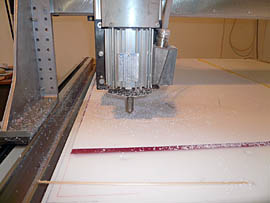 |
I could nod in agreement. It was already in the workshop - it's basically a computer-controlled milling machine that my friend from the model car hobby built for me on order.
Is such detailed consultation typical for the Czech environment as well?
Usually not. However, Joseph Pleskot knows a lot about what he wants, constantly creates a bit, intervenes a lot in the process, and carefully selects the materials. He has it within his house, just through the stairs. Jakub Cigler also comes with a clear idea; so does Martin Roubík, for whom I prepared, for example, a model for a museum in Cairo and much earlier a model of the Alexandria Library for Snohetta.
COMPETITION (AND) VISUALIZATION
Your model workshop is today one of the largest, if not the largest Czech company almost exclusively dedicated to creating architectural models. How did you come to this specialization?I know very little about my competition. But in terms of the number of people and production, we will probably be one of the largest. But I think that more than I know.
And how did it happen? At the age of ten, or maybe even earlier, I started making models of cars and airplanes with my father and then on my own...
So almost a classic path...
It wasn’t that smooth. I wanted to pursue something entirely different, but due to the situation in the country, I ended up at a construction secondary school after gymnasium. After graduation, I worked briefly as a construction worker, but I did not stop with models. After a while, I went into design, and for about four years I worked at the design institute of the capital city of Prague, then maybe two years in an atelier with Šrámková, which at that time was located on Alšovo waterfront, where there was also a model workshop... I went there to peek with Mr. Bláha. And then the opportunity arose: In 1981, architect Slíva opened a new model workshop in the architectural service...
At first, we learned from Slíva, and around 1985 we began working on models for the design of a pavilion for the World Expo in Vancouver for D. A. Studio, that is, for Martin Rajniš, and consequently for the Art Centre...
And so I ended up in Vancouver for four months. I worked a bit there and looked around; I even considered staying in Canada. I found one model workshop for architectural models there... When I later showed my wife the photos at home, I said: Look, I will have a workshop like this one day. That was in the summer of 1986.
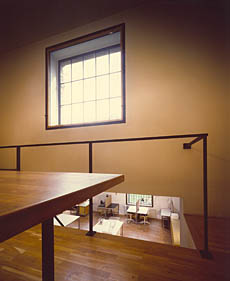 |
I returned. Slíva fell ill and died in February 1987. I took over leadership from him, but the socialist system did not amuse me much. Opportunities for granting permits for small businesses appeared, and so I became a private entrepreneur in the autumn of 1988. By 1989, I had already effectively employed two people.
When you now manage the workshop, do you miss working manually with the material?
But I still do something. Just this morning I was cutting contours for Letná. I still keep my own table in the workshop...
Are you not worried that the era of models could end? That they could be replaced by 3D visualizations in the future?
By the way, Foster has his own model workshop inside his studio. Friends have been reminding me of the threat from computer competition for a good fifteen years. But personally, I am not very afraid. For several reasons: Models have been made since ancient China, in Egypt - simply throughout history. People who decide on money generally have a very poor spatial imagination. It’s easier for them to grasp a tangible model. Another reason is that no matter how great and tough people are, they are playful, and each model somehow tunes one’s psyche. And the third reason, from my point of view, is absolutely clear. When I was with Martin Roubík in Egypt, there was a preparation for an exhibition of all the competitive proposals for the Great Egyptian Museum - the largest architectural competition in the world. They had maybe three A4s prescribed, and one of them was a visualization. A total of 1800 proposals were submitted. And even though the subject was prescribed, each visualization looked different: sometimes Cairo was close, sometimes far away, sometimes the pyramids were on the right, other times on the horizon, sometimes high, sometimes low. A computer visualization can be so easily adapted to a particular intention! The model cannot do that. You cannot cheat on a model. All mistakes are revealed in the model.
Does such verification actually work in practice?
Certainly. This year we prepared large models for a Czech investor who halted the production of one model in February and by August, the project changed because he discovered on the model that he would incur heavy losses on the earthworks... And that’s what models are for: They can catch errors that are corrected on the construction site at a thousand times the cost. And sometimes, they are irreparable. You can toss a model in the trash, but a building...
Thank you for the interview.
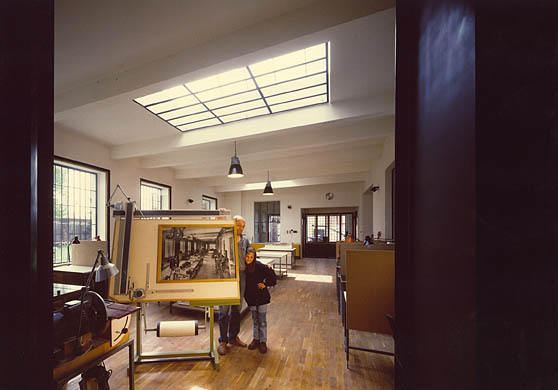 |
Photographs: Pavel Štecha (3, 4, 6, 7), Kateřina Lopatová (1, 2, 5)
The English translation is powered by AI tool. Switch to Czech to view the original text source.
2 comments
add comment
Subject
Author
Date
Modelařina
Martin
31.01.08 11:55
..
Zbyněk
29.04.13 11:34
show all comments










